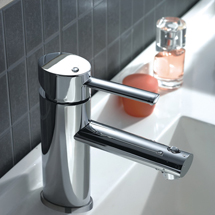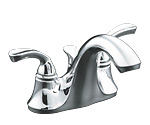
Leaky faucets could be a thing of the past with top-notch valves and tough finishes now common on all but the cheapest models. Most faucets also have lifetime warranties that cover leaks and stains.
There're few performance differences between brands. So faucets buying tips should should base on finish.
Types
There are two main types of faucets. If you are replacing an older faucet, your choice may be limited to the configuration of your current sink and/or counter. But it you are buying a new sink and faucet that the same time, here are the types of faucets to consider.
| Single lever You move the lever to one side or the other for hot or cold, or somewhere midway to mix. In the kitchen, some cooks prefer a faucet with a spout on a hose that can be pulled out from the faucet head. Single-lever faucets are easier to use and install than two separate side-mounted handles. | |
| Side-mounted handles Two handles may allow slightly more precise temperature adjustments than a single lever. Howerver, A faucet with side-mounted handles is harder to install. | |
Single-lever faucets take up less counter space. And they're more convenient if your hands aren't clean and you're trying not to soil the handle. But they may not allow quite as precise temperature adjustments as do side-mounted handles.
With less clearance from the backsplash, you're more likely to bang your knuckles as you turn the handle. And side-mounted handles are less convenient if your hands aren't clean and you're trying not to soil the handles.
Features
Advances in faucet finishes have made most faucets good at resisting wear. Here are some other faucet features to consider that can affect durability and function.
| Spout shape | |
| Spray/stream selector | |
| Temperature setting Finish | |
Tough finishes are common on all but the cheapest kitchen faucets.PVD finishes resisted our best attempts at scratching them. But corrosives such as drain cleaner can stain them slightly. Chrome, another popular finish, is quite durable, but a heavy-duty scouring pad can scratch it. Without the PVD finish, bronze was the least resistant to abrasion in our tests.
Pullout spout
A spout that pulls out of the faucet head on a hose increases flexibility. A counterweight helps the hose and spout to retract neatly. The hose should be long enough to reach into all corners of the sink.
Tips
| Side handles are harder to use Overall, single-handle faucets are easier to use. But those with a side-mounted handle aren't as easy, especially if your hands aren't clean and you're trying not to dirty the handle. | |
Bronze finishes aren't the same
Bronze offers an alternative to the shiny metal look. We tested two bronze faucets. The one without the PVD finish was the least resistant finish in our abrasion tests. The one with the PVD finish was fine.
Count holes
Most sinks come with mounting holes drilled for faucets. If you're not changing sinks, you'll need to match what you have or get a base plate to cover extra holes. It's not a good idea to try to drill additional holes in an existing sink or countertop.
| | Consider spout styles and function Straight-spout models are compact and often inexpensive, but you might need to move the faucet to fit a big pot under it. Gooseneck models have higher clearances, but they can cause splashing if your sink is shallow. |
Think about installation and repair
Replacing a faucet and a sink at the same time is easier because the faucet can be installed in the sink or counter before the sink is put in place. Fittings that can be tightened with a screwdriver also streamline installation. Long water-supply hoses let you make connections lower in the sink cabinet, where tools are easier to use.
written by Nicolas Yang















